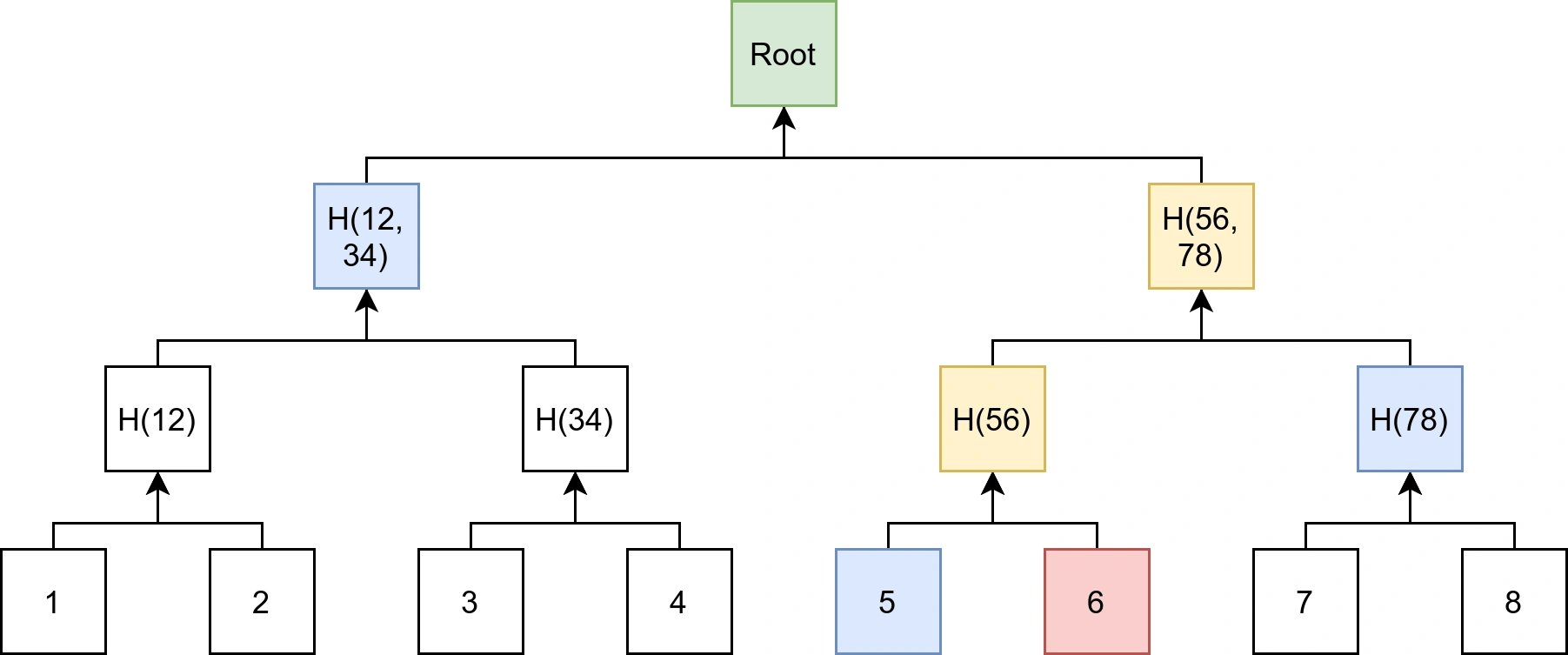Merkle Tree
Merkle树,也称为二叉哈希树,是一种用于计算机科学应用中的数据结构。在区块链技术的背景下,Merkle树用于更高效和安全地编码区块链数据。[1]
概述
在比特币的区块链中,一个区块的交易通过一个算法生成哈希值,这是一个数字和字母的字符串,可以用来验证给定的数据集与原始交易集是否相同。每笔交易都被哈希,然后每对交易被连接并一起哈希,以此类推,直到整个区块只有一个哈希值。这种结构类似于一棵树,底行的哈希值被称为“叶子”,中间的哈希值被称为“分支”,顶部的哈希值被称为“根”。
给定区块的Merkle根存储在头部。Merkle树允许用户在不下载整个区块链的情况下验证特定的交易。例如,如果有人想验证一个特定的交易是否包含在一个区块中,他们可以查询网络关于该交易的哈希值,网络将返回必要的哈希值来验证一切都已考虑在内。[1][4][7]

- 高效安全的数据验证: Merkle树允许对大型数据集进行高效和安全的验证。这在区块链技术中至关重要,因为数据量可能非常大并且不断增长。
- 交易验证: 例如,在比特币的区块链中,Merkle树允许用户在不下载整个区块链的情况下验证特定的交易。这对于轻量级的SPV(简化支付验证)客户端特别有用,它们只下载区块链的一个子集来验证交易。
- 数据完整性和一致性: 存储在区块头中的Merkle根有助于确保区块中所有交易的完整性和一致性。如果任何单个交易发生变化,都将导致不同的Merkle根。
- 防止双重支付: 通过确保每个交易区块都引用前一个区块,Merkle树有助于防止双重支付,这是一种数字现金方案中潜在的缺陷,即用户可以多次花费同一笔钱。
历史
Merkle树的概念最初由Ralph Merkle在1987年发表的一篇题为“基于传统加密功能的数字签名”的论文中提出。他还发明了密码哈希。Merkle树背后的技术于1989年获得专利。
在比特币发明之前,密码学被用于软件开发中以保护数据安全。在以公钥密码学闻名的Merkle引入Merkle树用于验证对等网络中的数据完整性之后,他引入了哈希的概念,作为一种新的验证行为模式。Merkle树现在被用于各种应用中,包括对等网络、分布式系统和区块链技术。它们是比特币和以太坊等加密货币运行的基础。[1][5][9]
Merkle树的类型
根据每个父节点可以拥有的子节点数量,有不同类型的Merkle树。一些例子是:[8]
- 二叉Merkle树: 这些是最简单和最常见的Merkle树类型,其中每个父节点只有两个子节点。它们用于有效地总结和验证大型数据集,例如文件或交易。
- Patricia树: 这是一种更复杂的Merkle树类型,用于以太坊中处理智能合约的交易。Patricia树每个父节点可以有更多的子节点,使其适用于更复杂的操作。
用例
Merkle树有广泛的应用,特别是在需要数据完整性检查的系统中。以下是一些值得注意的应用,Merkle树的应用也扩展到许多其他领域:[2][7][10]
- 加密货币: Merkle树是比特币和以太坊等加密货币运行的基础。它们用于有效地存储和验证区块中的交易。
- 分布式系统: 诸如对等网络之类的分布式系统使用Merkle树来确保从其他对等方接收的数据块是完整且未更改的。
- 文件系统: 诸如星际文件系统(IPFS)、Btrfs和ZFS之类的文件系统使用Merkle树来防止数据降级。
- 数据库: 诸如Dynamo DB和Apache Cassandra之类的可扩展数据库使用Merkle树。
- 证书透明度: 证书颁发机构使用Merkle树来验证证书透明度。
- 数字签名: Merkle树用于数字签名。
- 数据完整性检查: 任何需要检查不一致性的系统都可以使用Merkle树。
- 股票交易: 需要跟踪每日股票交易活动的应用程序是Merkle树可能有用处的一个完美例子。
例子
Merkle树的一些实现示例是:[7]
- IPFS: IPFS是一种用于在分布式文件系统中存储和共享文件的对等协议。IPFS使用Merkle树将文件和目录表示为Merkle DAG(有向无环图)。DAG中的每个节点都由唯一的哈希值标识,并且与其他节点的链接被编码为数据的一部分。这允许跨网络高效地进行数据去重、验证和同步。
- ZFS: ZFS是一种文件系统,提供诸如数据完整性、压缩、加密和快照之类的功能。ZFS使用Merkle树来存储文件系统的元数据,例如文件名、大小、权限和校验和。每个数据块都有一个校验和,该校验和存储在其父块中,形成一棵以根块结尾的树。这允许检测和纠正数据损坏,以及验证快照和备份的一致性。
- 以太坊: 以太坊是一个支持智能合约和去中心化应用程序的区块链平台。以太坊使用Merkle树来存储网络的状态,例如帐户、余额、交易和合约代码。以太坊使用Merkle树的一种变体,称为Patricia树,每个父节点可以有两个以上的子节点,并且可以有效地存储键值对。Patricia树能够快速证明数据的存在和不存在,以及轻客户端协议。
